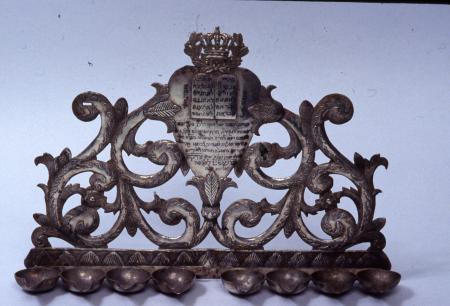Obj. ID: 22096
Sacred and Ritual Objects Ner Hanukkah from the Beit Abraham Congregation, Ioannina, 1868

The Hanukkah lamp consists of a back wall and a row of oil containers.
A row of eight spouted oil containers, organized in two groups of four, is fastened to the bottom of the back wall. An additional container, used as a shamash (server), was attached to the left upper part of the back wall (now missing).
The arched back wall is composed of two symmetrical interlaced scrolled branches, emerging from an acanthus leaf in the centre and flanking a heart-shaped shield. The shield encloses a double-arched Tables of the Covenant inscribed with the Ten Commandments, five on each side, and mounted over a dedicatory inscription. A citation from Proverbs borders the Tables:
"כי נר מצוה/ ותורה אור" (משלי ו:כג).
“For the commandment is a lamp; and the law is light” (Prov. 6:23).
The inscription “כתר תורה” "The Crown of Torah” identifies the crest, formed as a crown flanked by a wreath of olive branches.
The dedicatory inscription inscribed in square, linear Hebrew characters, in eight lines, and reads (fig. 1):
"הנרות חנוכה של כסף הללו הקדישם/ האשה הגבירת מרת שרה ת''ם (תבורך מנשים, מבוסס על שופטים ה:כד) לק''ק (קהל קדוש) בית/ אברהם יע''א (יכוננה עליון אמן) לחייה ולמנוחת בעלה כה''ר (כבוד הרב)/ אברהם שלמה נ''ע (נוחו עדן) והיה בבואו אל/ הקודש (מבוסס על שמות כח:כט; ויקרא י:יח, טז:כג; יחזקאל מד:כז) ביום כ''ה תברכו לחודש/ כסלו אתן שנת 'אהב צדקה/ ומשפט' (תהלים לג:ה) לפ''ג (לפרט גדול) פה/ יאנינא יע''א (יבנה עירו אמן)."
“These silver Hanukkah candles (see: Remarks: no.1) were dedicated by the woman of substance, Mrs. Sarah blessed above women (Judg. 5:24), for the Holy congregation Beit Abraham (The house of Abraham), may the Sublime establish it, amen, for her life and for the repose of her husband, the honourable Rabbi Abraham Salomon, may he rest in Eden. And when it (the Hanukkah lamp) goeth into the Sanctuary (based on Ex. 28:29; Lev. 10:18, 16:23; Ezek. 44:27) on the blessed (day), the 25th of the month of Kislev, (the year) 'I will give a year of love, righteousness and judgment' (based on Ps. 33:5 'He loveth righteousness and judgment' = 09.12.1868), here Ioannina, may He build His city, amen.”
The sum of the letters of the verse "צדקה ומשפט" ("righteousness and judgment") written in large and bold letters, indicates the year 5629, which corresponds to Hanukkah, 1868.
A suspension loop is attached to the top of the reverse side of the back wall.



